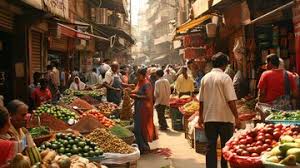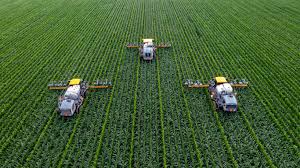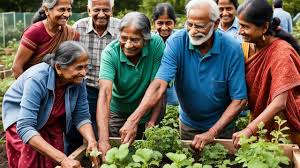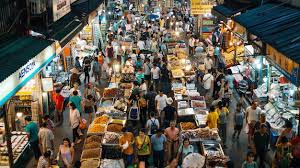Global population growth refers to the increase in the number of individuals inhabiting the Earth over time. Since ancient times, human populations have steadily expanded.
Global population growth has a significant impact on various sectors, especially agriculture, as it directly influences food production and availability. With the world’s population expected to reach nearly 10 billion by 2050, the demand for food is rising at an unprecedented rate.
This rapid growth places enormous pressure on agricultural systems, which must adapt to meet the needs of a growing population while facing challenges such as limited arable land, water scarcity, and climate change.
Agriculture plays a vital role in sustaining human life by providing the food and raw materials necessary for survival and economic development. However, as more people require food, the agricultural sector must produce more, often in increasingly difficult circumstances.
This challenge is particularly acute in developing countries, where population growth rates are highest and agricultural practices may not be as advanced. Farmers in these regions often face limited access to modern farming technologies, which hinders their ability to produce sufficient food to meet the demands of their expanding populations.
To tackle these challenges, innovations in agriculture are essential. Sustainable practices, such as precision farming, vertical farming, and genetically modified crops, offer solutions to increase yields and optimize resource use.
Moreover, adopting climate-resilient crops and improving soil health are crucial strategies to enhance food security and ensure that agricultural systems can withstand environmental changes.
The connection between population growth and agriculture also highlights the need for strategic policies. Governments and organizations must work together to invest in agricultural research, support small-scale farmers, and promote efficient food distribution systems.
By addressing these issues, the global community can create a more resilient agricultural system that meets the needs of a growing population while protecting the environment for future generations.
Projected Population Increase: Trends and Statistics

1. Current Population Trends: As of 2024, the global population stands at approximately 7.9 billion people. This population is not evenly distributed, with some regions experiencing rapid growth while others stabilize or decline.
2. Future Projections: By 2050, it is estimated that the global population will increase by nearly 1.8 billion people, reaching around 9.7 billion. This growth will vary significantly by region, with Sub-Saharan Africa expected to see the most substantial increase in population size.
3. Impact of Population Growth: The increase in population size has profound implications for societies worldwide. It places greater demands on resources such as food, water, energy, and infrastructure, challenging our ability to sustainably support growing populations.
Factors Driving the Demand for Food
1. Population Growth: The primary driver of increased food demand is simply the growing number of people worldwide. More individuals require more food to sustain themselves, placing pressure on global food systems.
2. Changing Diets: Economic development often leads to shifts in dietary preferences. As incomes rise, individuals tend to consume more animal products and processed foods, which require more resources (such as water and land) to produce compared to plant-based diets.
3. Urbanization: Urbanization is the process by which populations increasingly reside in urban areas rather than rural ones. Urban residents typically have different dietary habits, often favoring processed foods and convenience items, which further increases demand for food production and distribution systems.
Challenges in Meeting Global Food Demand
1. Limited Arable Land: Arable land, suitable for agriculture, is finite and often already under cultivation. Expanding agricultural land can lead to deforestation and environmental degradation, exacerbating climate change and biodiversity loss.
2. Climate Change: Climate change disrupts agricultural productivity through altered weather patterns, increased occurrences of extreme weather events (such as droughts and floods), and shifts in pest and disease prevalence. These factors threaten global food security by reducing crop yields and compromising agricultural stability.
3. Water Scarcity: Agriculture is a water-intensive activity, accounting for a significant portion of global water usage. Water scarcity, exacerbated by climate change and competing demands from other sectors, poses a critical challenge to sustainable food production.
Agricultural Innovations to Sustain Food Supply
1. Precision Agriculture: Precision agriculture utilizes technologies such as Global Positioning Systems (GPS), sensors, and drones to optimize farming practices. By precisely managing inputs like water, fertilizer, and pesticides, farmers can enhance crop yields while minimizing waste and environmental impact.
2. Genetic Engineering: Genetic engineering involves modifying the genetic makeup of crops to enhance desirable traits, such as pest resistance, drought tolerance, and nutritional content. These genetically modified organisms (GMOs) can improve agricultural productivity and resilience in the face of climate change and pest outbreaks.
3. Vertical Farming: Vertical farming is a method of growing crops indoors in stacked layers, often in urban environments. This approach maximizes land use efficiency, reduces water consumption, and minimizes transportation costs associated with food distribution.
4. Aquaculture: Aquaculture involves farming aquatic organisms such as fish, shellfish, and aquatic plants under controlled conditions. It provides a sustainable source of seafood to meet the growing global demand while reducing pressure on wild fisheries.
5. Smart Irrigation: Smart irrigation systems use real-time data and technology to deliver water precisely where and when crops need it most. By optimizing water use efficiency, these systems conserve water resources and enhance crop productivity in water-limited regions.
Read Also: 5 Amazing Health Benefits of Triphala (Three fruits)
Sustainable Farming Practices for Future Food Security

Sustainable farming practices play a crucial role in ensuring future food security by minimizing environmental impact, preserving natural resources, and promoting long-term agricultural resilience. These practices encompass a range of techniques and principles aimed at optimizing crop yields while maintaining ecosystem health.
1. Conservation Agriculture: Conservation agriculture focuses on minimizing soil disturbance, maintaining soil cover, and rotating crops to enhance soil fertility and reduce erosion. By preserving soil structure and organic matter, farmers can sustainably increase productivity over time.
2. Agroforestry: Agroforestry integrates trees and shrubs into agricultural landscapes, providing multiple benefits such as improved soil fertility, biodiversity conservation, and climate resilience. Tree crops can also diversify income sources for farmers.
3. Organic Farming: Organic farming avoids synthetic pesticides and fertilizers, relying instead on natural inputs like compost and crop rotations to manage pests and enhance soil health. This method promotes biodiversity and produces food with lower environmental impacts.
4. Permaculture: Permaculture designs agricultural systems based on natural ecosystems’ principles, emphasizing diversity, resilience, and self-sufficiency. By mimicking natural patterns, permaculture maximizes resource efficiency and minimizes waste.
5. Integrated Crop-Livestock Systems: Integrated systems combine crop production with livestock grazing or poultry farming, optimizing nutrient cycling and improving land productivity. This approach enhances farm resilience by diversifying income streams and reducing input costs.
The Role of Technology in Food Production
Technology plays a pivotal role in modern food production, enhancing efficiency, sustainability, and resilience against challenges like climate change and population growth.
1. Precision Agriculture: Precision agriculture utilizes technologies such as GPS, sensors, and drones to monitor and manage crop growth conditions in real-time. By precisely applying water, fertilizers, and pesticides, farmers can optimize yields while minimizing environmental impact.
2. Biotechnology and Genetic Engineering: Biotechnology enables the development of genetically modified organisms (GMOs) with traits like pest resistance, drought tolerance, and enhanced nutritional content. These innovations improve crop yields and resilience in adverse conditions.
3. Vertical Farming: Vertical farming involves growing crops indoors in vertically stacked layers, using controlled-environment agriculture techniques. This method conserves space, reduces water usage, and minimizes transportation costs, making it suitable for urban areas.
4. Aquaponics and Hydroponics: Aquaponics combines fish farming (aquaculture) with hydroponic plant cultivation in a symbiotic environment. This closed-loop system recycles nutrients and water, maximizing resource efficiency and producing both fish and vegetables sustainably.
Addressing Food Distribution and Access Inequities
Ensuring equitable access to nutritious food is essential for food security. Addressing distribution challenges and inequities can help alleviate hunger and improve public health outcomes globally.
1. Food Redistribution Networks: Food redistribution initiatives connect surplus food from farms, manufacturers, and retailers with food-insecure communities. These networks reduce food waste and improve access to nutritious food for vulnerable populations.
2. Infrastructure Investment: Governments and organizations invest in transportation, storage, and distribution infrastructure to facilitate efficient food supply chains. Improved infrastructure reduces food losses during transit and ensures timely delivery to remote areas.
3. Nutrition Education and Food Assistance Programs: Nutrition education programs educate consumers about healthy eating habits and sustainable food choices. Food assistance programs provide subsidies, vouchers, or direct food aid to low-income individuals and families, ensuring they have access to nutritious food.
Read Also: How Guava Fruits and Leaves Improve Female Fertility
Government and Global Initiatives to Support Food Security

Government policies and international initiatives play a critical role in promoting food security through sustainable agricultural development, economic support, and humanitarian aid.
1. Sustainable Development Goals (SDGs): The United Nations’ SDGs include targets for achieving zero hunger, promoting sustainable agriculture, and ensuring food security for all by 2030. Member states collaborate to implement policies and initiatives that support these goals.
2. Agricultural Subsidies and Support: Governments provide subsidies, grants, and loans to farmers to improve agricultural productivity, invest in technology adoption, and enhance resilience against climate change impacts.
3. International Aid and Development Programs: International organizations and donor countries provide aid and development assistance to improve agricultural infrastructure, support smallholder farmers, and strengthen food systems in developing countries.
Global population growth presents both challenges and opportunities for ensuring food security worldwide. Meeting the increasing demand for food requires innovative approaches in agriculture, technology, and resource management.
By implementing sustainable practices and embracing technological advancements, we can work towards a future where everyone has access to safe, nutritious, and sufficient food supplies.
Sustainable farming practices, technological innovations, equitable food distribution, and supportive government policies are essential pillars for achieving global food security.
By promoting environmentally friendly agricultural practices, leveraging technology for efficiency, addressing food distribution inequities, and fostering international cooperation, we can build a more resilient and food-secure future for all.
Do you have any questions, suggestions, or contributions? If so, please feel free to use the comment box below to share your thoughts. We also encourage you to kindly share this information with others who might benefit from it. Since we can’t reach everyone at once, we truly appreciate your help in spreading the word. Thank you so much for your support and for sharing!
Read Also: The Effect of Solid Waste on Business Environments
Frequently Asked Questions
We will update this section soon.

